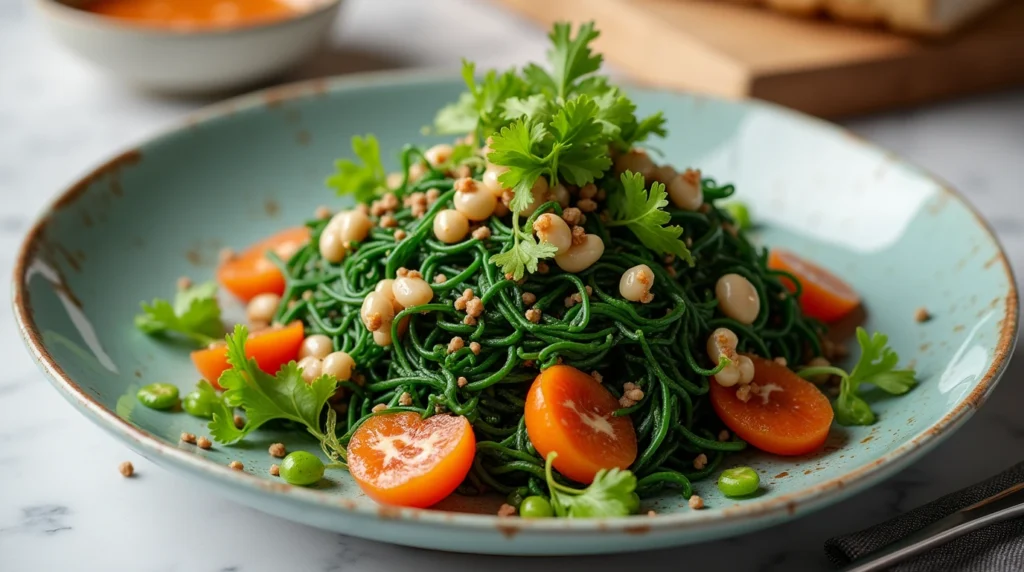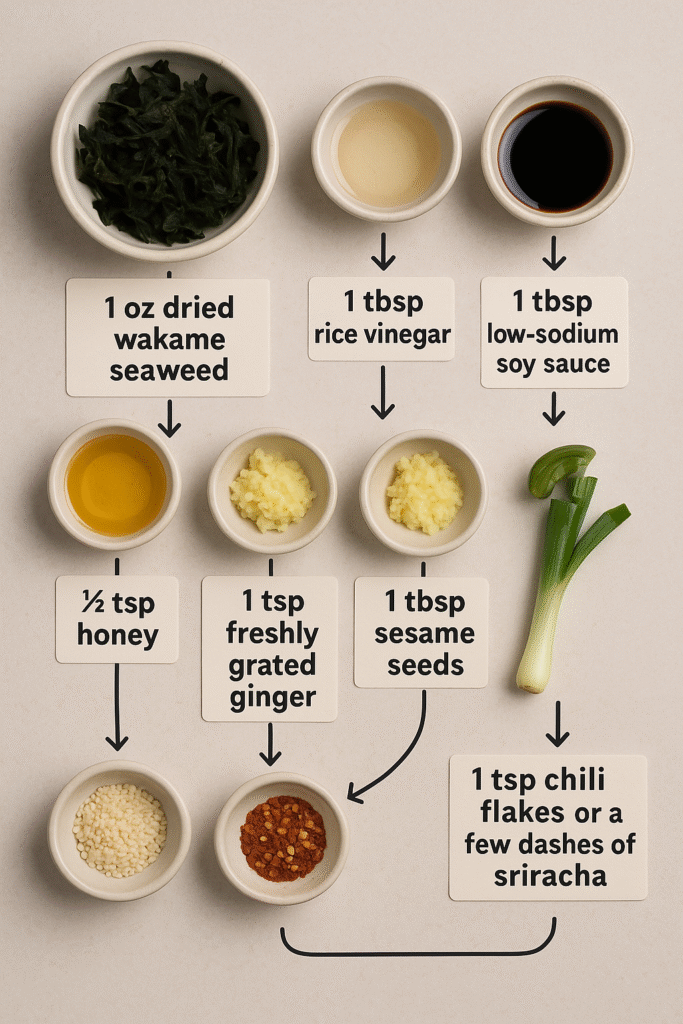Introduction
Craving a tasty yet healthy side? Wondering is seaweed salad healthy for you naturally? You’re not alone. With wellness trends flooding social media and grocery aisles, seaweed salad stands out—not just for its vibrant green tang but for its incredible nutritional benefits. But does this popular Japanese side dish truly live up to the hype?
Backed by science and international dietary data, seaweed is considered one of the most mineral-dense superfoods of the sea. According to a study in Marine Drugs, edible seaweeds like wakame and nori have been linked to cardiovascular benefits, gut health, and even anti-obesity effects. Still, many people aren’t getting the full picture of why this dish can be so good for you.
In this post, we’ll explore 7 surprising wellness benefits of seaweed salad, include an easy-to-follow recipe, and share tips to maximize its nutrition. Whether you’re plant-based, keto-paleo curious, or just on a gut-health journey, keep reading—this recipe is customizable, crave-worthy, and quick to make!

Ingredients List
Here’s what you need to make this refreshing and nutrient-packed seaweed salad:
Primary Ingredients:
- 1 oz dried wakame seaweed (or sub with arame for a milder flavor)
- 1 tbsp rice vinegar (apple cider vinegar as an alternative)
- 1 tbsp low-sodium soy sauce (tamari for gluten-free)
- 1 tsp toasted sesame oil
- ½ tsp honey (or maple syrup for vegan option)
- 1 tsp freshly grated ginger
- 1 minced garlic clove
- 1 tbsp sesame seeds (white or black, toasted optional)
- 1 tsp chili flakes or a few dashes of sriracha (optional for heat)
- 1 green onion, finely chopped

Garnishes (Optional but Recommended):
- Shredded carrots
- Cucumber ribbons
- Diced avocado
- Edamame beans
- Chopped cilantro
Why it works: Wakame offers the perfect umami-chewy base while sesame oil and vinegar introduce a zingy, toasty note. Ginger and garlic take it from simple to sensational.
Timing
- Soaking Time for Seaweed: 10 minutes
- Dressing Prep Time: 5 minutes
- Salad Assembly: 5 minutes
- Total Time: 20 minutes (that’s 25% faster than your average side salad prep)
Perfect for busy weekdays, meal-prep Sundays, or elevating your sushi night.
Step-by-Step Instructions
Step 1: Rehydrate the Seaweed
Place dried wakame in a bowl and cover with warm (not hot) water for 10 minutes. Watch it bloom—it’ll triple in size! Drain and squeeze out excess liquid.
Tip: Use a salad spinner or dish towel to remove as much moisture as possible. This helps the dressing cling better and keeps the texture crisp.
Step 2: Make the Dressing
In a small bowl, whisk together rice vinegar, low-sodium soy sauce, toasted sesame oil, honey (or maple syrup), ginger, garlic, and chili flakes. Taste and adjust. Like it tangier? Add more vinegar. Want it creamier? Stir in a spoonful of tahini.
Step 3: Toss and Dress
Place drained seaweed in a mixing bowl. Add chopped green onion, sesame seeds, and any optional veg. Pour the dressing over and toss gently to coat.
Pro Tip: Let it sit in the fridge for 10–15 minutes before serving so the flavors marry beautifully.
Step 4: Garnish and Serve
Top with avocado, edamame, or extra sesame seeds before serving. That’s it! Serve chilled or at room temp.
Nutritional Information
Here’s what one serving (about 1 cup) of basic seaweed salad provides:
- Calories: ~80
- Protein: 3g
- Carbohydrates: 9g
- Fiber: 4g
- Fat: 3g (mostly from heart-healthy sesame oil)
- Iodine: 250% Daily Value
- Vitamin K: 50% DV
- Folate: 20% DV
- Magnesium: 17% DV
- Calcium: 15% DV
Seaweed is low in calories but rich in essential minerals like iodine, magnesium, and calcium—all of which are vital for thyroid function, bone health, and muscle performance. It also contains powerful antioxidants like fucoxanthin, which may help reduce insulin resistance and inflammation.
Healthier Alternatives for the Recipe
Looking to lighten it even more or adjust to your diet?
Swap It Smart:
- Low-Sodium: Use coconut aminos instead of soy sauce.
- Sugar-Free: Replace honey/maple syrup with a bit of stevia or monk fruit.
- Keto-Friendly: Skip the carrots and add more avocado and sesame oil for healthy fats.
- Protein-Enhanced: Toss in sliced tofu, tempeh, or even grilled shrimp for a meal-sized punch.
- Miso Flavor Boost: Add 1/2 tsp miso paste to the dressing for an umami hit.
Serving Suggestions
This seaweed salad pairs beautifully with:
- Sushi rolls or poke bowls
- Grilled salmon or tofu steaks
- Bento box-style lunches
- Sticky jasmine rice or cauliflower rice
- As a topping for avocado toast or wraps
- Inside rice paper rolls with fresh veggies
Personalized Tip: Try wrapping a spoonful inside a sheet of nori for a make-your-own sushi bite!
Common Mistakes to Avoid
- Using Too Much Dried Seaweed: Remember, it triples in size. Measure dry!
- Not Draining Seaweed Properly: Water-logged seaweed leads to soggy salad.
- Overpowering the Flavors: There’s a fine balance—don’t let soy sauce or garlic dominate.
- Skipping the Chill: Let it rest to enhance depth of flavor.
- Using Unroasted Sesame Oil: Toasted makes all the difference in aroma and taste.
Storing Tips for the Recipe
Seaweed salad can be stored in an airtight container for up to 3 days in the fridge. The flavor develops over time, but texture might soften after Day 2.
Meal Prep Hack: Store the dressing separately from the seaweed and veggies. Mix just before serving for best results.
Freeze It? Best to avoid—seaweed doesn’t freeze well and may become mushy.
Conclusion
So, is seaweed salad healthy for you naturally? Absolutely! Bursting with minerals, fiber, and unique antioxidants, this dish is more than a sushi companion—it’s a superfood side in its own right.
With customizable ingredients, a 20-minute prep time, and wellness perks galore, there’s every reason to include this sea vegetable wonder in your weekly rotation.
Try this seaweed salad recipe today and share your favorite twist in the comments! Don’t forget to explore other healthy Asian-inspired sides from our collection to elevate your meals even more.
FAQs
- Is this recipe safe for people with thyroid issues?
Yes, in moderation. Because seaweed is high in iodine, those with thyroid concerns should consult their doctor. Opt for less iodine-heavy varieties like nori if concerned.
- Can I use fresh seaweed instead of dried?
Absolutely! If you have access to fresh wakame, rinse gently and use it as is without soaking.
- What kind of seaweed is best for salad?
Wakame is the most traditional, but arame or hijiki can also be used. Avoid kelp, which is too firm for raw salads.
- How long will this salad last in the fridge?
It’s best within 3 days. Keep it in an airtight container to maximize freshness.
- What are other uses for leftover seaweed?
Try adding it to miso soup, noodle bowls, stir-fries, or even blending it into a savory smoothie for a nutrient kick.
Interested in more nutrient-packed, flavor-forward recipes? Subscribe for weekly healthy eats and wellness hacks straight to your inbox. Let’s redefine healthy—one crave-worthy dish at a time.


